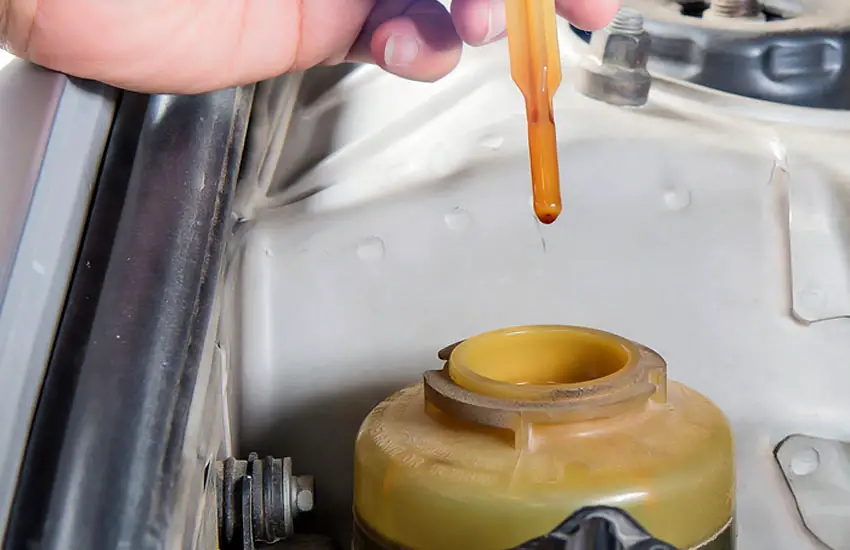As an Amazon Associate, I earn from qualifying purchases at no extra cost to you.
What Color is Power Steering Fluid When It Leaks?
Power steering fluid is a vital component of your vehicle’s steering system, allowing you to steer smoothly with minimal effort. When this fluid leaks, it can cause a variety of issues, ranging from difficulty in steering to complete loss of steering function.
So, when your car starts showing signs of a power steering fluid leak, it's essential to understand what you’re dealing with. One of the first things you might wonder is, “What color is power steering fluid when it leaks?”
This is a common question and one that can give you important clues about the health of your car's steering system. In this blog post, we will explore the color of power steering fluid, how it changes with age, and what it might mean if you notice different colors leaking from your vehicle.

Understanding Power Steering Fluid: The Basics
Before diving into the specific colors and their meanings, it’s important to first understand what power steering fluid is and how it works. Power steering fluid is a hydraulic fluid that helps to transmit the force from the steering wheel to the steering mechanism, which ultimately makes it easier for you to turn the vehicle’s wheels.
In most cars, the power steering system operates under high pressure. The fluid flows through the power steering pump, hoses, and rack or gear. When the system is working properly, you should be able to turn your steering wheel effortlessly. However, when there's a leak in the system, the fluid level drops, leading to a loss of hydraulic pressure and making the steering harder to control.
Now, let's take a closer look at the color of power steering fluid and what it might indicate if you notice it leaking from your car.
The Color of Power Steering Fluid and Its Meaning
When power steering fluid leaks, it can change color due to various factors such as age, exposure to air, and the presence of contaminants. Understanding these color changes can help you diagnose the issue with your vehicle and determine whether it's something simple to fix or if it requires professional attention.
New Power Steering Fluid: Bright Red or Pink
Fresh power steering fluid is typically bright red or pink in color. This vibrant hue comes from the dyes added to the fluid to help it stand out, making it easier to spot leaks and diagnose potential issues. The color of the fluid is usually consistent across most brands and types of power steering fluid. However, some vehicles may use a different type of fluid, which could slightly alter the color, but it generally remains within the red or pink spectrum.
Bright red or pink fluid indicates that the power steering system is in good condition and the fluid is still fresh. If you notice fresh red fluid leaking from your vehicle, it might suggest that there is a new leak somewhere in the system. This could be due to a cracked hose, a loose fitting, or a problem with the power steering pump. While this type of leak is not necessarily urgent, it's important to address it promptly before the fluid level drops too low and the steering system starts to malfunction.
Dark Red or Brown Power Steering Fluid
Over time, as the power steering fluid circulates through the system, it begins to degrade. The fluid may turn from bright red or pink to a darker red or even brown. This color change is typically a sign that the fluid is aging and may no longer be as effective as it once was. The fluid could be contaminated with small metal particles from the power steering pump or other components, which can contribute to its discoloration.
If you notice dark red or brown fluid leaking from your vehicle, it's an indication that the power steering fluid has likely been in the system for a while and is starting to break down. While this fluid may still function in the short term, it's advisable to get your power steering fluid replaced and check for any underlying issues in the system. If the fluid has turned brown, it could also be a sign that your power steering system is under a lot of stress or that the pump is wearing out.
Black Power Steering Fluid
Black power steering fluid is a major red flag. It typically indicates that the fluid has become excessively contaminated with dirt, debris, and metal shavings. The presence of these particles in the fluid could be a sign of severe wear within the power steering pump or other components of the system. When power steering fluid turns black, it means the fluid is no longer providing optimal lubrication and protection, and it may be damaging the system even further.
If you notice black power steering fluid leaking from your vehicle, it's important to have it inspected by a mechanic as soon as possible. The black color indicates that the fluid is old, heavily contaminated, and no longer effective. In this case, a fluid flush, along with the replacement of any worn components, may be necessary to restore proper function to your steering system.
Clear or Amber Fluid
In some cases, you might find that the power steering fluid has become clear or amber in color. This is a rare occurrence and usually indicates that the fluid is relatively new but has lost some of its dye due to extensive use. While clear or amber fluid doesn't necessarily indicate a problem with the power steering system, it is still a good idea to keep an eye on the fluid level and check for leaks. If the fluid remains clear for an extended period or starts to develop a burnt odor, it may be time to replace it and check for any issues with the system.
Milky or Foamy Fluid
If the power steering fluid appears milky or foamy, it could indicate that there is air or moisture in the system. This can happen if the power steering fluid reservoir cap is not properly sealed, allowing air to enter the system. Alternatively, it could be a sign that the fluid has become contaminated with water, which can happen if the vehicle is exposed to a lot of moisture or if there's a leak in the power steering system that allows water to mix with the fluid.
Milky or foamy fluid is not ideal for the power steering system, as it can reduce the fluid's ability to lubricate and transmit pressure effectively. If you notice this type of fluid leaking, it's a good idea to get the system inspected and flushed to remove any contaminants.
What Causes Power Steering Fluid to Leak?
There are several common reasons why power steering fluid might leak from your vehicle. Understanding these causes can help you pinpoint the issue and take the appropriate steps to address it.
Worn or Cracked Hoses
The hoses in your power steering system carry the fluid between various components, such as the pump, rack, and steering gear. Over time, these hoses can become brittle, crack, or develop leaks. If the hoses are not properly maintained or have been exposed to extreme temperatures, they can allow fluid to escape, leading to a leak. If you notice a puddle of bright red fluid under your car, this may be the cause of the problem.
Leaking Power Steering Pump
The power steering pump is a crucial part of the system, responsible for generating the pressure needed to assist with steering. If the pump becomes damaged or the seals wear out, it can start leaking fluid. A leaking power steering pump can be identified by fluid pooling around the area of the pump. If the pump is not functioning properly, it may need to be replaced to restore proper steering functionality.
Worn Steering Rack or Gear
The steering rack or gear is another component that can develop leaks over time. If the seals in the rack or gear become damaged, fluid may start leaking from the system. This type of leak can be more difficult to detect since the fluid may leak slowly over time and be absorbed by the surrounding components. A worn steering rack or gear can lead to difficulty steering and should be addressed by a mechanic as soon as possible.
Loose or Damaged Fittings
The fittings and connections in the power steering system can sometimes become loose or damaged. If these fittings are not properly tightened, they can allow fluid to leak out. In some cases, a simple tightening of the fittings may solve the problem. However, if the fittings are damaged, they may need to be replaced.
Damaged Seals or Gaskets
Seals and gaskets are used throughout the power steering system to prevent fluid from leaking out. Over time, these seals can wear out, crack, or become damaged, leading to leaks. If you notice a slow leak or a decrease in the level of power steering fluid, it's worth checking the seals and gaskets for any signs of damage. Replacing these seals can help stop the leak and restore proper function to the system.
I hope this guide helps you understand the color of power steering fluid when it leaks and what it might indicate about your vehicle's steering system. Whether your fluid is bright red, brown, black, or milky, each color can provide valuable clues about the condition of your power steering system. Keep an eye on the fluid levels, and if you notice any unusual leaks, it's important to address the issue promptly to avoid further damage to your vehicle's steering components.
Are These Questions in Your Mind?
Is it normal for power steering fluid to leak?
If you notice a power steering fluid leak, it’s usually not normal. A leak can indicate a problem with your power steering system that needs to be addressed.
Can I drive my car with a power steering fluid leak?
It’s not recommended to drive with a power steering fluid leak, as it can lead to difficulty steering and damage to your vehicle's power steering system.
Do I need to replace my power steering fluid if it turns brown?
Yes, brown power steering fluid should be replaced as it indicates the fluid is old and no longer providing optimal lubrication.
Is it expensive to fix a power steering fluid leak?
The cost to fix a power steering fluid leak can vary depending on the severity of the issue, but it may be relatively affordable if it's just a hose or fitting that needs replacing.
Can a power steering fluid leak cause damage to my engine?
While a power steering fluid leak doesn't directly impact your engine, losing too much fluid can cause the steering system to fail, which could lead to unsafe driving conditions.
Is it safe to drive with low power steering fluid?
Driving with low power steering fluid is not safe, as it can make steering difficult and could cause further damage to the power steering pump.
Do I need to replace my power steering pump if it leaks?
If your power steering pump is leaking, it may need to be repaired or replaced, depending on the extent of the damage.
Can power steering fluid leak from the reservoir?
Yes, if the reservoir cap is not sealed properly or if the reservoir itself is damaged, power steering fluid can leak from it.
Is it possible for power steering fluid to leak without being noticed?
Yes, sometimes power steering fluid leaks slowly, making it difficult to detect. Regularly checking fluid levels can help spot leaks early.
Can power steering fluid leaks cause steering problems?
Yes, a power steering fluid leak can cause steering problems, including difficulty in turning the wheel and a loss of hydraulic pressure in the steering system.











